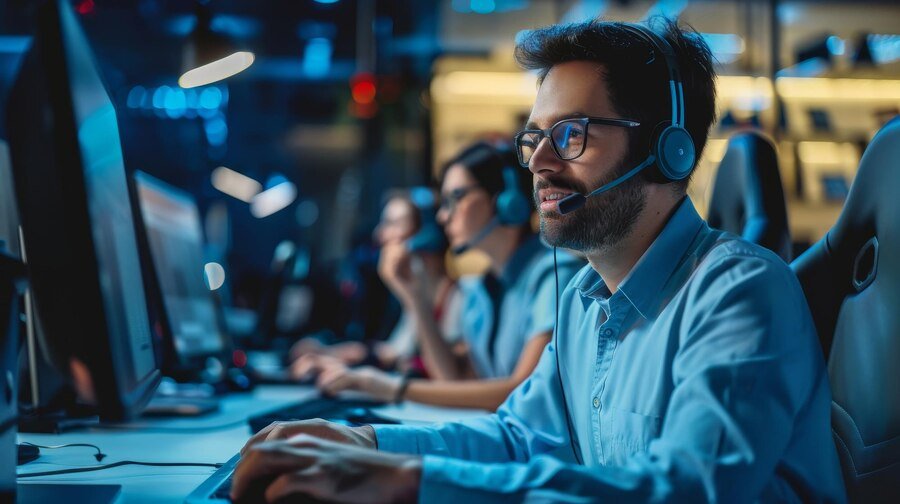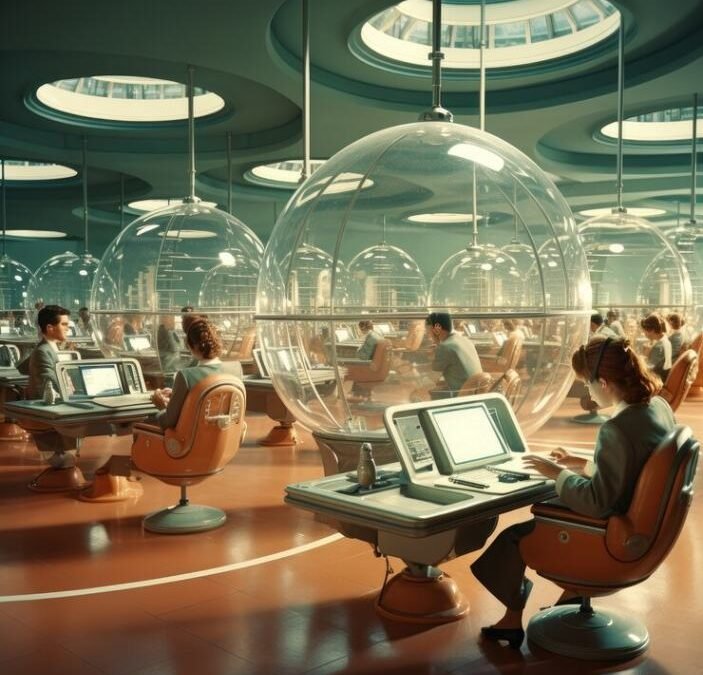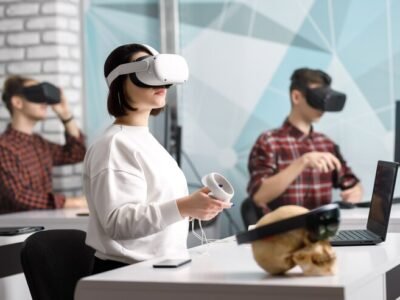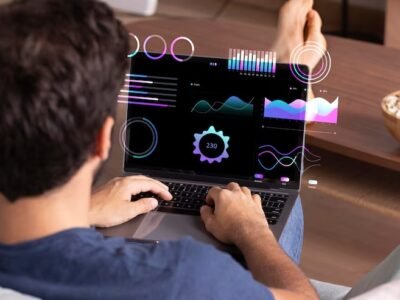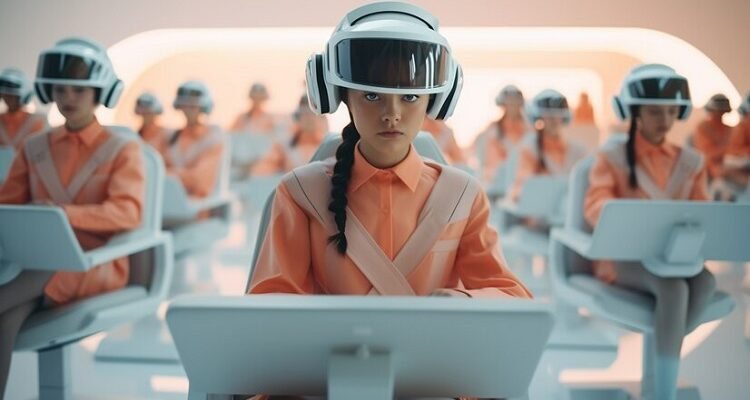
Instead of sitting in a classroom, staring at a textbook or whiteboard, you find yourself transported to the heart of ancient Rome, walking through the grand Colosseum as if you were there centuries ago. Or maybe you’re exploring the depths of the ocean, observing marine life up close without ever getting wet. This is the transformative power of virtual reality (VR) in education – a technology that’s revolutionizing the way we teach and learn.
As VR becomes increasingly accessible and adopted in classrooms worldwide, it’s opening up a world of possibilities for immersive, engaging, and effective learning experiences. From fostering better knowledge retention to developing essential skills, the benefits of incorporating VR into the educational system are vast and far-reaching.
Key Takeaways
- Virtual reality creates highly immersive and interactive learning environments, transporting students to different locations, time periods, and scenarios.
- Research shows that the multi-sensory nature of VR enhances information processing and knowledge retention, making it an effective tool for teaching complex concepts.
- VR can improve accessibility and inclusivity in education, accommodating diverse learning styles and needs, including students with disabilities.
- By simulating real-world situations, VR helps develop critical thinking, problem-solving, collaboration, and social-emotional skills essential for success.
- While challenges exist, the future of VR in education is promising, with ongoing advancements and integration with emerging technologies like the metaverse.
Understanding Virtual Reality in Education
Let’s start by defining virtual reality (VR) and its core components. VR technology involves using a headset or goggles to create an immersive, computer-generated environment that simulates real-world or imaginary scenarios. As users move their heads, the visuals adjust accordingly, creating a sense of presence within the virtual environment.
Over the years, VR tech has evolved from bulky, expensive setups to more accessible and affordable options, like the Meta Quest (formerly Oculus) headsets. This has paved the way for its integration into educational settings, where educators and students can reap the benefits of this cutting-edge technology.
As of today, VR is being adopted in classrooms worldwide, from elementary schools to universities. While the rate of adoption varies, the potential of VR in education is undeniable, and its impact is already being felt across various subjects and disciplines.
Immersive Learning Experiences
One of the most significant benefits of using virtual reality in education is the ability to create highly engaging and immersive learning experiences. Imagine being able to take your students on a virtual field trip to the Great Pyramids of Giza or the International Space Station – all without leaving the classroom!
By leveraging VR, educators can transport learners to different locations, time periods, and scenarios that would otherwise be impossible or impractical to experience in real life. This hands-on, interactive approach to learning can help students better understand and retain information, as they’re able to visualize and interact with the subject matter in a more tangible way.
- Virtual field trips and simulations
- Historical reenactments and cultural explorations
- Exploration of scientific concepts and phenomena
For example, a VR experience could allow students to explore the inner workings of the human body, observe chemical reactions at the molecular level, or witness historical events as if they were there. The possibilities are endless, and the level of immersion can truly bring the subject matter to life.
Improved Knowledge Retention and Comprehension
But it’s not just about the “wow” factor – research has consistently shown that VR can significantly improve knowledge retention and comprehension. Here’s why:
| Benefit | Explanation |
|---|---|
| Multi-sensory learning | By engaging multiple senses (sight, sound, touch, etc.), VR helps solidify information in the brain, leading to better recall and understanding. |
| Experiential learning | Instead of passively absorbing information, VR allows students to actively participate and learn through experience, making the knowledge more meaningful and lasting. |
| Personalized learning | VR content can be tailored to individual learning styles and needs, ensuring that each student has an optimal learning experience. |
Studies have demonstrated that students who learn through VR simulations or experiences often outperform their peers who learn through traditional methods. This is particularly true for subjects that involve complex concepts or spatial relationships, such as anatomy, engineering, or astronomy.
Enhanced Accessibility and Inclusivity
Another significant advantage of VR in education is its ability to enhance accessibility and inclusivity. For students with disabilities or special needs, VR can provide a level playing field and create opportunities for learning that might not have been possible with traditional teaching methods.
For instance, students with mobility issues can explore virtual environments without physical limitations, while those with hearing or visual impairments can benefit from customized VR content tailored to their specific needs. By breaking down barriers and providing more inclusive learning experiences, VR can help ensure that no student is left behind.
Developing Essential Skills
Beyond just academic knowledge, VR can also play a crucial role in developing essential skills that are invaluable in today’s world. By simulating real-world scenarios and challenges, VR can help students cultivate critical thinking, problem-solving, and collaboration abilities.
For example, VR simulations can recreate emergency situations, allowing students to practice decision-making and crisis management skills in a safe, controlled environment. Or, students can work together in virtual teams to tackle complex engineering or design challenges, fostering teamwork and communication abilities.
Furthermore, VR experiences that expose students to different cultures, perspectives, and situations can help build emotional intelligence, empathy, and social awareness – skills that are increasingly valuable in our globalized, interconnected world.
Remember those medical students we mentioned earlier? Well, thanks to VR, they can now practice surgical procedures or patient interactions in a risk-free virtual setting, allowing them to gain valuable experience and confidence before entering the real-world operating room or clinic.
Overcoming Challenges and Considerations
Of course, like any new technology, there are challenges and considerations to address when implementing virtual reality in education. One of the primary concerns is the cost associated with purchasing VR equipment and developing high-quality VR content.
While the cost of VR headsets has become more affordable in recent years, creating immersive and engaging VR experiences requires significant investment in resources and expertise. Schools and educational institutions may need to explore creative funding solutions or partnerships to make VR accessible to their students.
Another challenge lies in the training and professional development required for educators to effectively integrate VR into their teaching practices. Without proper guidance and support, the impact of VR in the classroom may be limited.
Additionally, there are concerns around potential health and safety issues, such as motion sickness or eye strain, that need to be addressed when using VR for extended periods.
Despite these challenges, the potential benefits of VR in education far outweigh the drawbacks. With proper planning, training, and implementation strategies, educational institutions can overcome these hurdles and unlock the transformative power of VR for their students.
The Future of VR in Education
As exciting as the current state of VR in education is, the future holds even more promise. Ongoing advancements in VR technology, coupled with the integration of emerging technologies like the metaverse, will continue to reshape the educational landscape.
Imagine a world where students can seamlessly transition between physical and virtual learning environments, collaborating with peers from around the globe in shared virtual spaces. Or consider the potential of AI-powered VR assistants that can provide personalized guidance and support, tailoring the learning experience to each student’s unique needs and preferences.
The possibilities are endless, and as VR technology continues to evolve, so too will the ways in which it can enhance and revolutionize the educational experience.
Conclusion
In a world where technology is rapidly changing the way we live, work, and learn, virtual reality stands as a powerful tool for transforming education. By creating immersive, engaging, and effective learning environments, VR has the potential to revolutionize the way students acquire knowledge, develop essential skills, and prepare for the challenges of the future.
From improved knowledge retention and comprehension to enhanced accessibility and inclusivity, the benefits of using virtual reality in education are vast and far-reaching. As educators and institutions continue to explore and embrace this technology, they open up a world of possibilities for their students, equipping them with the tools and experiences they need to thrive in an ever-changing world.
So, whether you’re a student, teacher, or administrator, it’s time to embrace the magic of VR and embark on a journey of learning like never before. The future of education is here, and it’s more immersive, engaging, and transformative than ever.


